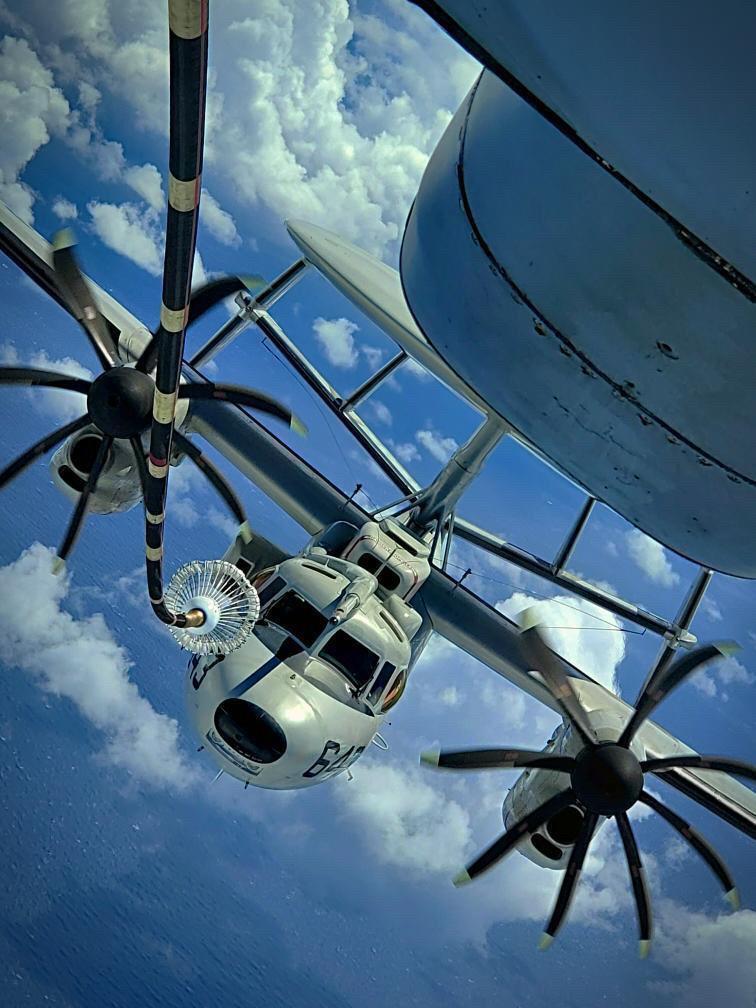Advanced Hawkeye Extends Reach for the Integratable Air Wing
Earlier this year, we introduced the term, the integratabtle air wing, to discuss the evolution of the role and capabilities of the evolving air wing on the large deck carrier.
Recently, VAW-126 Seahawks became the first Advanced Hawkeye squadron to qualify its pilots for air refueling.
We have been highlighting how re-imagining the role of the L class ship and the amphibious task force can enhance USMC-USN capability for sea denial and sea control, notably in the Pacific.
And the integratabtle air wing off of the large deck carrier can play a key role in this effort as well.
The importance of this development was not missed by Col. Gillette, the CO of MAWTS-1.
What does this mean for the Marines?
The Marines are shaping answers to this question: How can the Marines contribute most effectively to the core Navy mission of sea denial and sea control?
Part of the answer is to expand the role of the amphibious fleet and its onboard Marine Corps air and ground capability to play a key role in this mission.
An Advanced Hawkeye can augment the ability of this fleet to do this mission and with the extended range with air refueling of the Hawkeye plus the coming of the MQ-25 to the large deck carrier to do that air refueling mission, the prospects of taping into the capability of a member of the integratabtle air wing to provide ISR/C2 support for the amphibious task force is enhanced.
Our discussion with Col. Gillette, the CO of MAWTS-1, held yesterday in his office in Yuma will be published soon.
In a story issued on August 14, 2020 by Commander, Naval Forces Atlantic, the refueling event was highlighted.
The Seahawks of Airborne Command & Control Squadron (VAW-126) successfully became the U.S. Navy’s first fleet E-2D squadron to qualify its pilots in Aerial Refueling (AR) on Aug. 14.
After completing 81 simulator and aircraft training events, the Seahawks qualified their first two pilots on a U.S. Air Force KC-10 Extender aircraft from the 32nd Aerial Refueling Squadron based at Joint Base McGuire-Dix-Lakehurst, achieving 33 total plugs and receiving 12,000 pounds of fuel.
“The dedication displayed by our maintainers, our aircrew, and our Sailors is simply awe-inspiring. The squadron came together as a unified team to achieve this goal,” said Cmdr. Marc Foreman, the squadron’s commanding Officer.

Since Aug. 14, the squadron has successfully trained more than 10 pilots on aerial refueling with a U.S. Air Force KC-10 Extender and Omega 707. Aerial refueling is a significant airframe modification that is redefining the E-2D community’s impact in the carrier environment and war-fighting battlespace. It enables crews to increase mission persistence, cover longer distances in less time, and maximize operational flexibility.
“Adding aerial refueling to the Advanced Hawkeye is a game-changer,” added Foreman. “The women and men of VAW-126 are leading the way in its tactical development and employment.”
The AR modified E-2D is a key component to the carrier air wing of the future and VAW-126 is at the forefront as it integrates this new capability with the rest of Carrier Air Wing One and Carrier Strike Group Eight.
One of the first pilots to qualify in AR with a KC-10 Extender was Lt. Nicholas Dewispelaere, who is from Virginia Beach discussed the importance of this milestone.
“As an aviator we spend considerable time building proficiency on numerous mission sets, it is motivating and rewarding to master a new skill and develop this new capability,” said Dewispelaere.
VAW-126, a Norfolk, Virginia-based Advanced Hawkeye squadron is tasked with ushering in the AR modification to the Airborne Command & Control community and the fleet. The Seahawks are currently qualifying all of their pilots in day and night Aerial Refueling on the Omega 707 and KC-10 platforms. The Seahawks will work to expand their pilot’s AR experience to other tanker platforms, including the F/A-18 Super Hornet and KC-135 Stratotanker, at the same time developing the techniques and procedures for training and employment of this new capability.
